Co-Pyrolysis of Sewage Sludge and Wetland Biomass Waste for Biochar Production: Behaviors of Phosphorus and Heavy Metals
Abstract
:1. Introduction
2. Materials and Methods
2.1. Material Preparation
2.2. Thermogravimetric Analysis
2.3. Preparation of Biochar
2.4. Characterization of Biochar
2.5. Phosphorous Analysis
2.6. Determination of Heavy Metals
2.7. Statistical Analysis
3. Results and Discussion
3.1. Thermogravimetric Analysis of Sewage Sludge (SS) and Reed (RD)
3.2. Biochars
3.2.1. Biochar Yield
3.2.2. Biochar Characteristics
3.3. Transformation of P during the Co-Pyrolysis Process
3.3.1. Recovery of P in Biochars
3.3.2. Transformation of P
3.4. Removal of Heavy Metals
3.4.1. Total Contents of Heavy Metals in Biochars
3.4.2. Transformation of Zn
4. Conclusions
Supplementary Materials
Author Contributions
Funding
Institutional Review Board Statement
Informed Consent Statement
Data Availability Statement
Conflicts of Interest
References
- Xiong, Q.; Wu, X.; Lv, H.; Liu, S.; Hou, H.; Wu, X. Influence of rice husk addition on phosphorus fractions and heavy metals risk of biochar derived from sewage sludge. Chemosphere 2021, 280, 130566. [Google Scholar] [CrossRef]
- Chen, R.; Yuan, S.; Chen, S.; Ci, H.; Dai, X.; Wang, X.; Li, C.; Wang, D.; Dong, B. Life-cycle assessment of two sewage sludge-to-energy systems based on different sewage sludge characteristics: Energy balance and greenhouse gas-emission footprint analysis. J. Environ. Sci. 2022, 111, 380–391. [Google Scholar] [CrossRef] [PubMed]
- Djandja, O.S.; Yin, L.-X.; Wang, Z.-C.; Duan, P.-G. From wastewater treatment to resources recovery through hydrothermal treatments of municipal sewage sludge: A critical review. Process Saf. Environ. Prot. 2021, 151, 101–127. [Google Scholar] [CrossRef]
- Mattana, S.; Petrovičová, B.; Landi, L.; Gelsomino, A.; Cortés, P.; Ortiz, O.; Renella, G. Sewage sludge processing determines its impact on soil microbial community structure and function. Appl. Soil Ecol. 2014, 75, 150–161. [Google Scholar] [CrossRef]
- Wang, X.; Chang, V.W.; Li, Z.; Chen, Z.; Wang, Y. Co-pyrolysis of sewage sludge and organic fractions of municipal solid waste: Synergistic effects on biochar properties and the environmental risk of heavy metals. J. Hazard. Mater. 2021, 412, 125200. [Google Scholar] [CrossRef]
- Zheng, G.; Wang, X.; Chen, T.; Yang, J.; Yang, J.; Liu, J.; Shi, X. Passivation of lead and cadmium and increase of the nutrient content during sewage sludge composting by phosphate amendments. Environ. Res. 2020, 185, 109431. [Google Scholar] [CrossRef]
- Zhang, J.; Jin, J.; Wang, M.; Naidu, R.; Liu, Y.; Man, Y.B.; Liang, X.; Wong, M.H.; Christie, P.; Zhang, Y.; et al. Co-pyrolysis of sewage sludge and rice husk/ bamboo sawdust for biochar with high aromaticity and low metal mobility. Environ. Res. 2020, 191, 110034. [Google Scholar] [CrossRef]
- Bjorklund, K.; Li, L.Y. Adsorption of organic stormwater pollutants onto activated carbon from sewage sludge. J. Environ. Manag. 2017, 197, 490–497. [Google Scholar] [CrossRef]
- Bolan, N.; Hoang, S.A.; Beiyuan, J.; Gupta, S.; Hou, D.; Karakoti, A.; Joseph, S.; Jung, S.; Kim, K.-H.; Kirkham, M.B.; et al. Multifunctional applications of biochar beyond carbon storage. Int. Mater. Rev. 2021, 67, 150–200. [Google Scholar] [CrossRef]
- Biederman, L.A.; Harpole, W.S. Biochar and its effects on plant productivity and nutrient cycling: A meta-analysis. GCB Bioenergy 2013, 5, 202–214. [Google Scholar] [CrossRef]
- Dhanker, R.; Chaudhary, S.; Goyal, S.; Garg, V.K. Influence of urban sewage sludge amendment on agricultural soil parameters. Environ. Technol. Innov. 2021, 23, 101642. [Google Scholar] [CrossRef]
- Konczak, M.; Oleszczuk, P. Co-pyrolysis of sewage sludge and biomass in carbon dioxide as a carrier gas affects the total and leachable metals in biochars. J. Hazard. Mater. 2020, 400, 123144. [Google Scholar] [CrossRef] [PubMed]
- Yin, X.; Xi, M.; Li, Y.; Kong, F.; Jiang, Z. Improvements in physicochemical and nutrient properties of sewage sludge biochar by the co-pyrolysis with organic additives. Sci. Total Environ. 2021, 779, 146565. [Google Scholar] [CrossRef] [PubMed]
- Huang, H.-J.; Yang, T.; Lai, F.-Y.; Wu, G.-Q. Co-pyrolysis of sewage sludge and sawdust/rice straw for the production of biochar. J. Anal. Appl. Pyrolysis 2017, 125, 61–68. [Google Scholar] [CrossRef]
- Zhao, Y.; Ren, Q.; Na, Y. Phosphorus Transformation from Municipal Sewage Sludge Incineration with Biomass: Formation of Apatite Phosphorus with High Bioavailability. Energy Fuels 2018, 32, 10951–10955. [Google Scholar] [CrossRef]
- Jin, J.; Wang, M.; Cao, Y.; Wu, S.; Liang, P.; Li, Y.; Zhang, J.; Zhang, J.; Wong, M.H.; Shan, S.; et al. Cumulative effects of bamboo sawdust addition on pyrolysis of sewage sludge: Biochar properties and environmental risk from metals. Bioresour. Technol. 2017, 228, 218–226. [Google Scholar] [CrossRef]
- Wang, J.; Wang, W.; Xiong, J.; Li, L.; Zhao, B.; Sohail, I.; He, Z. A constructed wetland system with aquatic macrophytes for cleaning contaminated runoff/storm water from urban area in Florida. J. Environ. Manag. 2021, 280, 111794. [Google Scholar] [CrossRef]
- Cui, X.; Lu, M.; Khan, M.B.; Lai, C.; Yang, X.; He, Z.; Chen, G.; Yan, B. Hydrothermal carbonization of different wetland biomass wastes: Phosphorus reclamation and hydrochar production. Waste Manag. 2020, 102, 106–113. [Google Scholar] [CrossRef]
- Long, Y.-Y.; Hu, L.-F.; Fang, C.-R.; Wu, Y.-Y.; Shen, D.-S. An evaluation of the modified BCR sequential extraction procedure to assess the potential mobility of copper and zinc in MSW. Microchem. J. 2009, 91, 1–5. [Google Scholar] [CrossRef]
- Chen, G.; Tian, S.; Liu, B.; Hu, M.; Ma, W.; Li, X. Stabilization of heavy metals during co-pyrolysis of sewage sludge and excavated waste. Waste Manag. 2020, 103, 268–275. [Google Scholar] [CrossRef]
- Zhang, Z.; Ju, R.; Zhou, H.; Chen, H. Migration characteristics of heavy metals during sludge pyrolysis. Waste Manag. 2021, 120, 25–32. [Google Scholar] [CrossRef]
- Lin, Y.; Liao, Y.; Yu, Z.; Fang, S.; Ma, X. A study on co-pyrolysis of bagasse and sewage sludge using TG-FTIR and Py-GC/MS. Energy Convers. Manag. 2017, 151, 190–198. [Google Scholar] [CrossRef]
- Karayildirim, T.; Yanik, J.; Yuksel, M.; Bockhorn, H. Characterisation of products from pyrolysis of waste sludges. Fuel 2006, 85, 1498–1508. [Google Scholar] [CrossRef]
- Yang, H.; Yan, R.; Chen, H.; Lee, D.H.; Zheng, C. Characteristics of hemicellulose, cellulose and lignin pyrolysis. Fuel 2007, 86, 1781–1788. [Google Scholar] [CrossRef]
- Wen, Y.; Xie, Y.; Jiang, C.; Li, W.; Hou, Y. Products distribution and interaction mechanism during co-pyrolysis of rice husk and oily sludge by experiments and reaction force field simulation. Bioresour. Technol. 2021, 329, 124822. [Google Scholar] [CrossRef]
- Wang, Z.; Xie, L.; Liu, K.; Wang, J.; Zhu, H.; Song, Q.; Shu, X. Co-pyrolysis of sewage sludge and cotton stalks. Waste Manag. 2019, 89, 430–438. [Google Scholar] [CrossRef]
- Ephraim, A.; Minh, D.P.; Lebonnois, D.; Peregrina, C.; Sharrock, P.; Nzihou, A. Co-pyrolysis of wood and plastics: Influence of plastic type and content on product yield, gas composition and quality. Fuel 2018, 231, 110–117. [Google Scholar] [CrossRef]
- Lu, P.; Huang, Q.; Bourtsalas, A.C.; Chi, Y.; Yan, J. Synergistic effects on char and oil produced by the co-pyrolysis of pine wood, polyethylene and polyvinyl chloride. Fuel 2018, 230, 359–367. [Google Scholar] [CrossRef]
- Irfan, M.; Chen, Q.; Yue, Y.; Pang, R.; Lin, Q.; Zhao, X.; Chen, H. Co-production of biochar, bio-oil and syngas from halophyte grass (Achnatherum splendens L.) under three different pyrolysis temperatures. Bioresour. Technol. 2016, 211, 457–463. [Google Scholar] [CrossRef]
- Zhang, J.; Lu, F.; Zhang, H.; Shao, L.; Chen, D.; He, P. Multiscale visualization of the structural and characteristic changes of sewage sludge biochar oriented towards potential agronomic and environmental implication. Sci. Rep. 2015, 5, 9406. [Google Scholar] [CrossRef]
- Li, M.; Tang, Y.; Ren, N.; Zhang, Z.; Cao, Y. Effect of mineral constituents on temperature-dependent structural characterization of carbon fractions in sewage sludge-derived biochar. J. Clean. Prod. 2018, 172, 3342–3350. [Google Scholar] [CrossRef]
- Wang, X.; Chi, Q.; Liu, X.; Wang, Y. Influence of pyrolysis temperature on characteristics and environmental risk of heavy metals in pyrolyzed biochar made from hydrothermally treated sewage sludge. Chemosphere 2019, 216, 698–706. [Google Scholar] [CrossRef]
- Wang, T.; Chen, Y.; Li, J.; Xue, Y.; Liu, J.; Mei, M.; Hou, H.; Chen, S. Co-pyrolysis behavior of sewage sludge and rice husk by TG-MS and residue analysis. J. Clean. Prod. 2020, 250, 119557. [Google Scholar] [CrossRef]
- Jin, J.; Li, Y.; Zhang, J.; Wu, S.; Cao, Y.; Liang, P.; Zhang, J.; Wong, M.H.; Wang, M.; Shan, S.; et al. Influence of pyrolysis temperature on properties and environmental safety of heavy metals in biochars derived from municipal sewage sludge. J. Hazard. Mater. 2016, 320, 417–426. [Google Scholar] [CrossRef] [PubMed]
- Xiao, X.; Chen, B.; Zhu, L. Transformation, morphology, and dissolution of silicon and carbon in rice straw-derived biochars under different pyrolytic temperatures. Environ. Sci. Technol. 2014, 48, 3411–3419. [Google Scholar] [CrossRef]
- Magdziarz, A.; Wilk, M.; Gajek, M.; Nowak-Woźny, D.; Kopia, A.; Kalemba-Rec, I.; Koziński, J.A. Properties of ash generated during sewage sludge combustion: A multifaceted analysis. Energy 2016, 113, 85–94. [Google Scholar] [CrossRef]
- Barbooti, M.M.; Matlub, F.K.; Hadi, H.M. Catalytic pyrolysis of Phragmites (reed): Investigation of its potential as a biomass feedstock. J. Anal. Appl. Pyrolysis 2012, 98, 1–6. [Google Scholar] [CrossRef]
- Cui, X.; Yang, X.; Sheng, K.; He, Z.; Chen, G. Transformation of Phosphorus in Wetland Biomass during Pyrolysis and Hydrothermal Treatment. ACS Sustain. Chem. Eng. 2019, 7, 16520–16528. [Google Scholar] [CrossRef]
- Qian, T.-T.; Jiang, H. Migration of Phosphorus in Sewage Sludge during Different Thermal Treatment Processes. ACS Sustain. Chem. Eng. 2014, 2, 1411–1419. [Google Scholar] [CrossRef]
- Xu, G.; Zhang, Y.; Shao, H.; Sun, J. Pyrolysis temperature affects phosphorus transformation in biochar: Chemical fractionation and (31)P NMR analysis. Sci. Total Environ. 2016, 569–570, 65–72. [Google Scholar] [CrossRef]
- Liu, W.J.; Zeng, F.X.; Jiang, H.; Yu, H.Q. Total recovery of nitrogen and phosphorus from three wetland plants by fast pyrolysis technology. Bioresour. Technol. 2011, 102, 3471–3479. [Google Scholar] [CrossRef]
- Huang, R.; Tang, Y. Evolution of phosphorus complexation and mineralogy during (hydro)thermal treatments of activated and anaerobically digested sludge: Insights from sequential extraction and P K-edge XANES. Water Res. 2016, 100, 439–447. [Google Scholar] [CrossRef]
- Huang, R.; Fang, C.; Zhang, B.; Tang, Y. Transformations of Phosphorus Speciation during (Hydro)thermal Treatments of Animal Manures. Environ. Sci. Technol. 2018, 52, 3016–3026. [Google Scholar] [CrossRef]
- Huang, R.; Tang, Y. Speciation Dynamics of Phosphorus during (Hydro)Thermal Treatments of Sewage Sludge. Environ. Sci. Technol. 2015, 49, 14466–14474. [Google Scholar] [CrossRef] [PubMed]
- Jiang, Y.; Ren, C.; Guo, H.; Guo, M.; Li, W. Speciation Transformation of Phosphorus in Poultry Litter during Pyrolysis: Insights from X-ray Diffraction, Fourier Transform Infrared, and Solid-State NMR Spectroscopy. Environ. Sci. Technol. 2019, 53, 13841–13849. [Google Scholar] [CrossRef]
- Liu, Q.; Fang, Z.; Liu, Y.; Liu, Y.; Xu, Y.; Ruan, X.; Zhang, X.; Cao, W. Phosphorus speciation and bioavailability of sewage sludge derived biochar amended with CaO. Waste Manag. 2019, 87, 71–77. [Google Scholar] [CrossRef]
- Filho, J.F.L.; Penido, E.S.; Castro, P.P.; Silva, C.A.; Melo, L.C.A. Co-Pyrolysis of Poultry Litter and Phosphate and Magnesium Generates Alternative Slow-Release Fertilizer Suitable for Tropical Soils. ACS Sustain. Chem. Eng. 2017, 5, 9043–9052. [Google Scholar] [CrossRef]
- Huang, W.; Cai, W.; Huang, H.; Lei, Z.; Zhang, Z.; Tay, J.H.; Lee, D.J. Identification of inorganic and organic species of phosphorus and its bio-availability in nitrifying aerobic granular sludge. Water Res. 2015, 68, 423–431. [Google Scholar] [CrossRef] [PubMed]
- Xie, C.; Zhao, J.; Tang, J.; Xu, J.; Lin, X.; Xu, X. The phosphorus fractions and alkaline phosphatase activities in sludge. Bioresour. Technol. 2011, 102, 2455–2461. [Google Scholar] [CrossRef] [PubMed]
- Lu, T.; Yuan, H.; Wang, Y.; Huang, H.; Chen, Y. Characteristic of heavy metals in biochar derived from sewage sludge. J. Mater. Cycles Waste Manag. 2015, 18, 725–733. [Google Scholar] [CrossRef]
- Huang, H.J.; Yuan, X.Z. The migration and transformation behaviors of heavy metals during the hydrothermal treatment of sewage sludge. Bioresour. Technol. 2016, 200, 991–998. [Google Scholar] [CrossRef] [PubMed]
- Devi, P.; Saroha, A.K. Risk analysis of pyrolyzed biochar made from paper mill effluent treatment plant sludge for bioavailability and eco-toxicity of heavy metals. Bioresour. Technol. 2014, 162, 308–315. [Google Scholar] [CrossRef] [PubMed]
- Wang, Z.; Shu, X.; Zhu, H.; Xie, L.; Cheng, S.; Zhang, Y. Characteristics of biochars prepared by co-pyrolysis of sewage sludge and cotton stalk intended for use as soil amendments. Environ. Technol. 2020, 41, 1347–1357. [Google Scholar] [CrossRef] [PubMed]
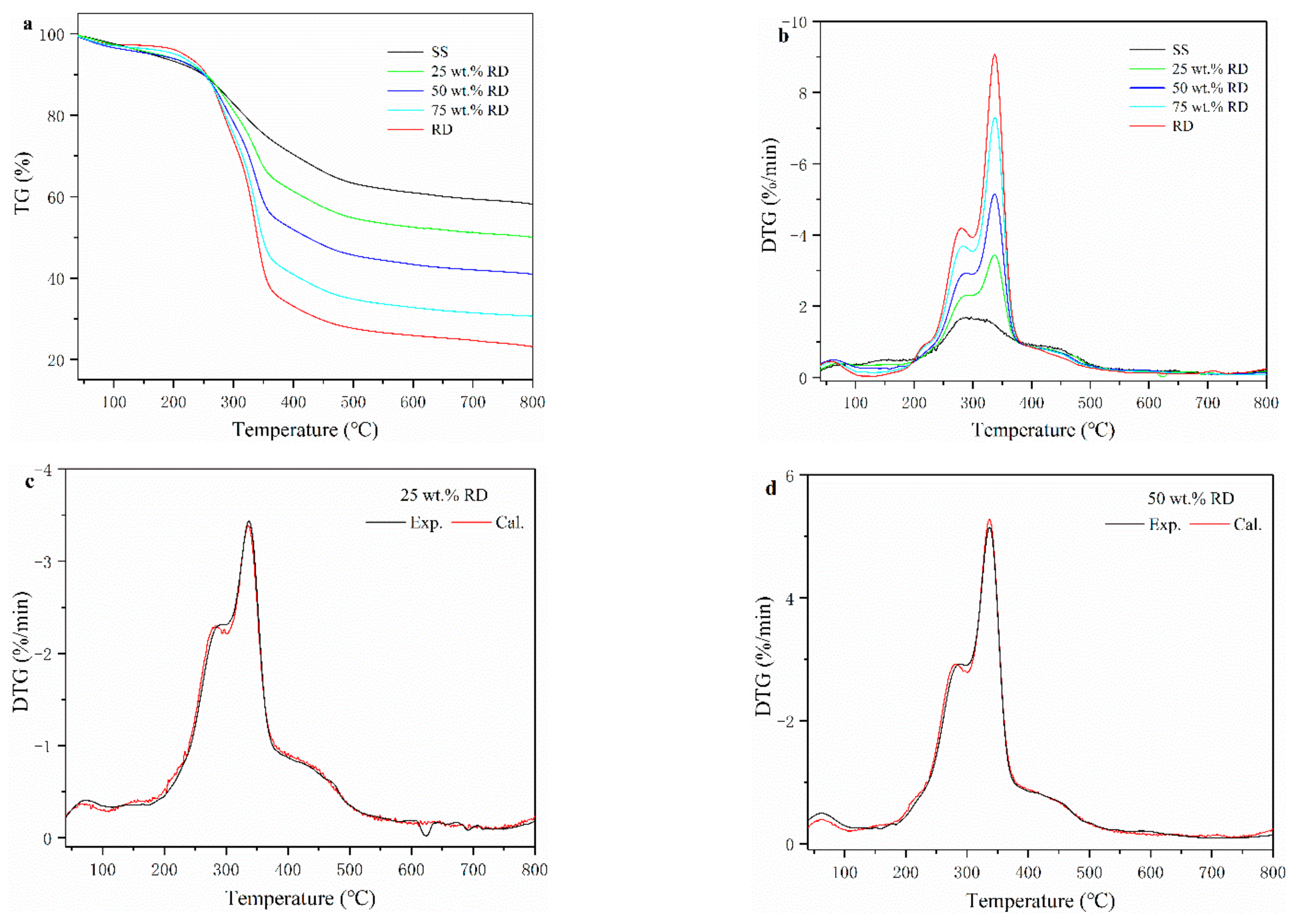
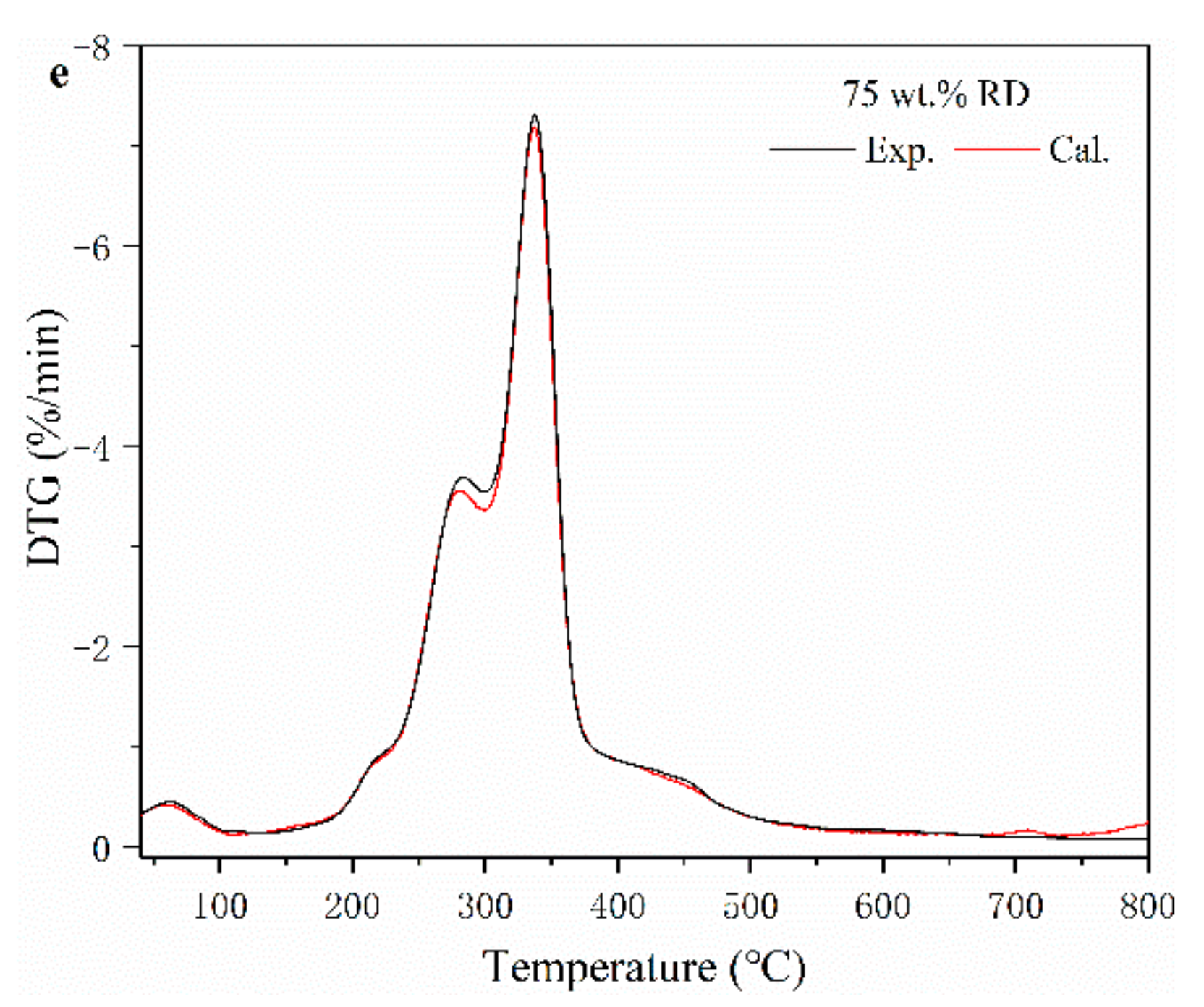
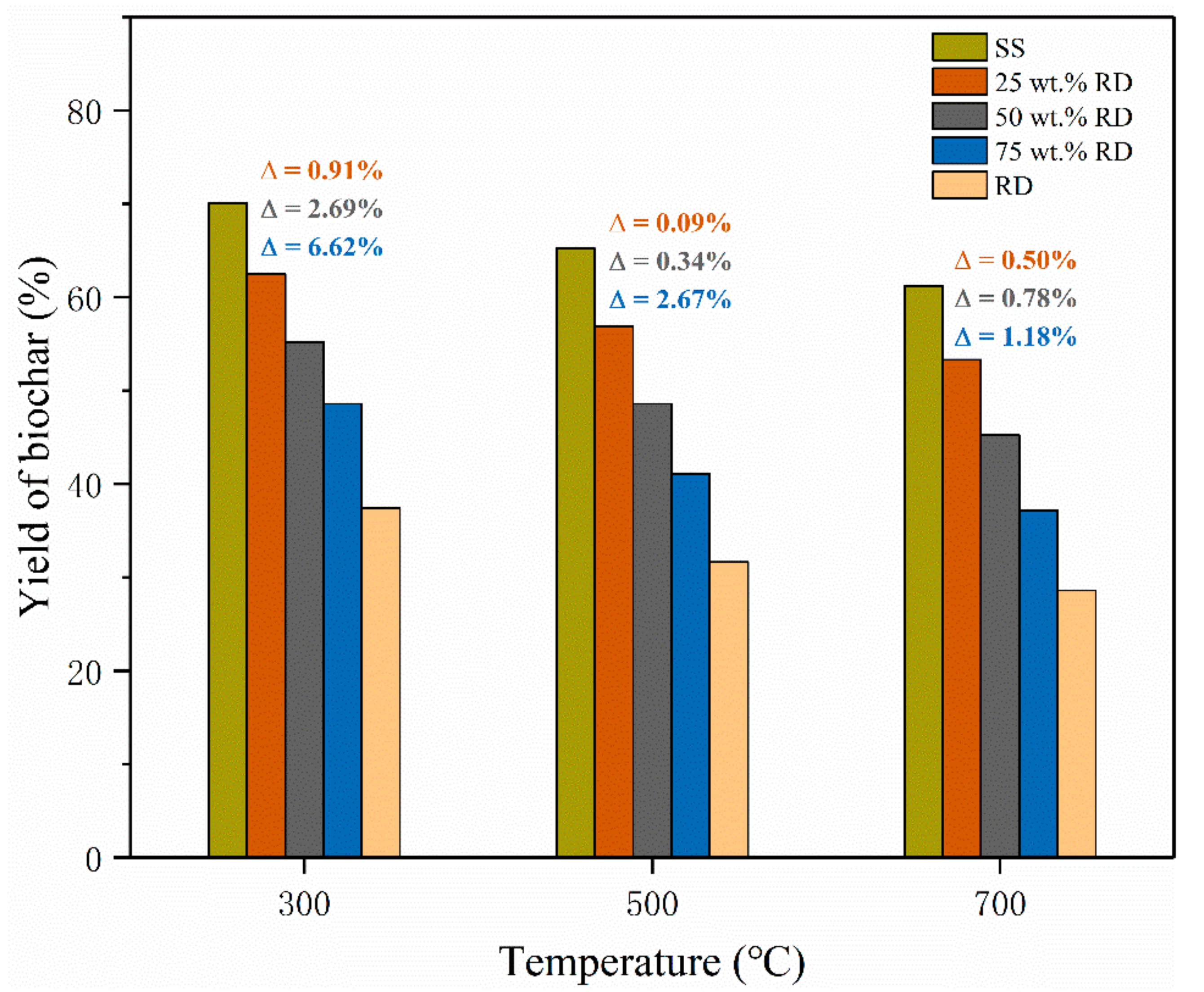
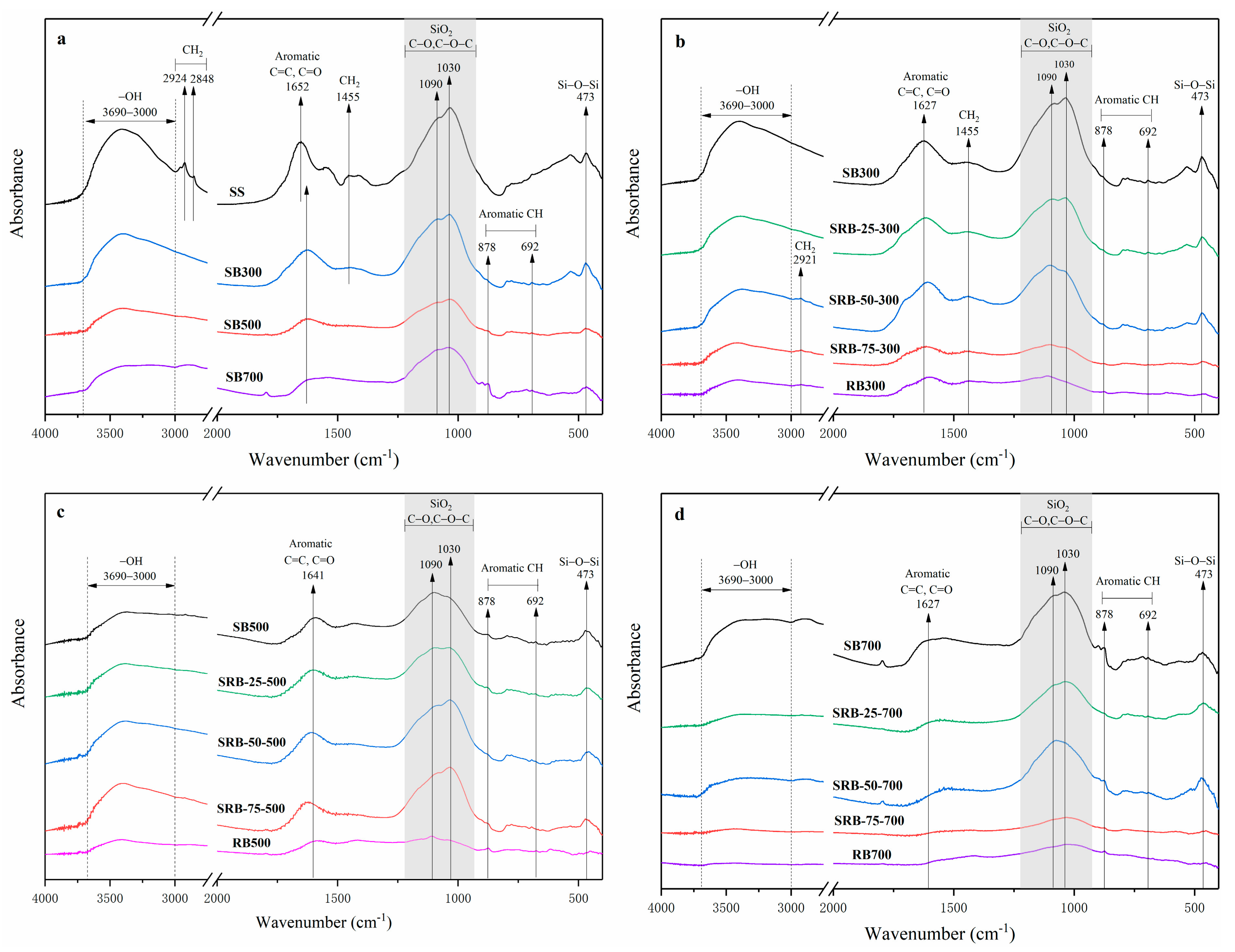
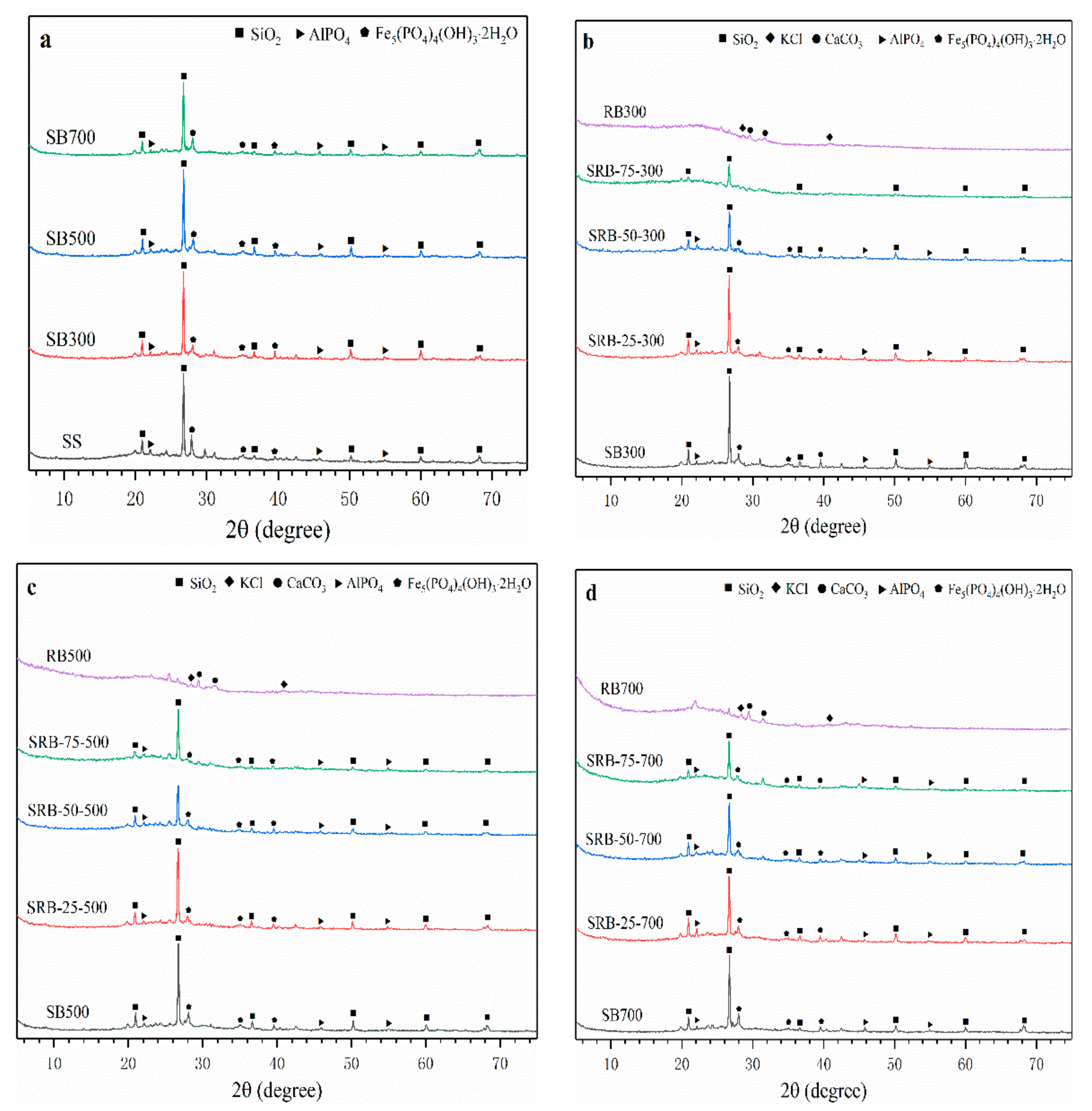
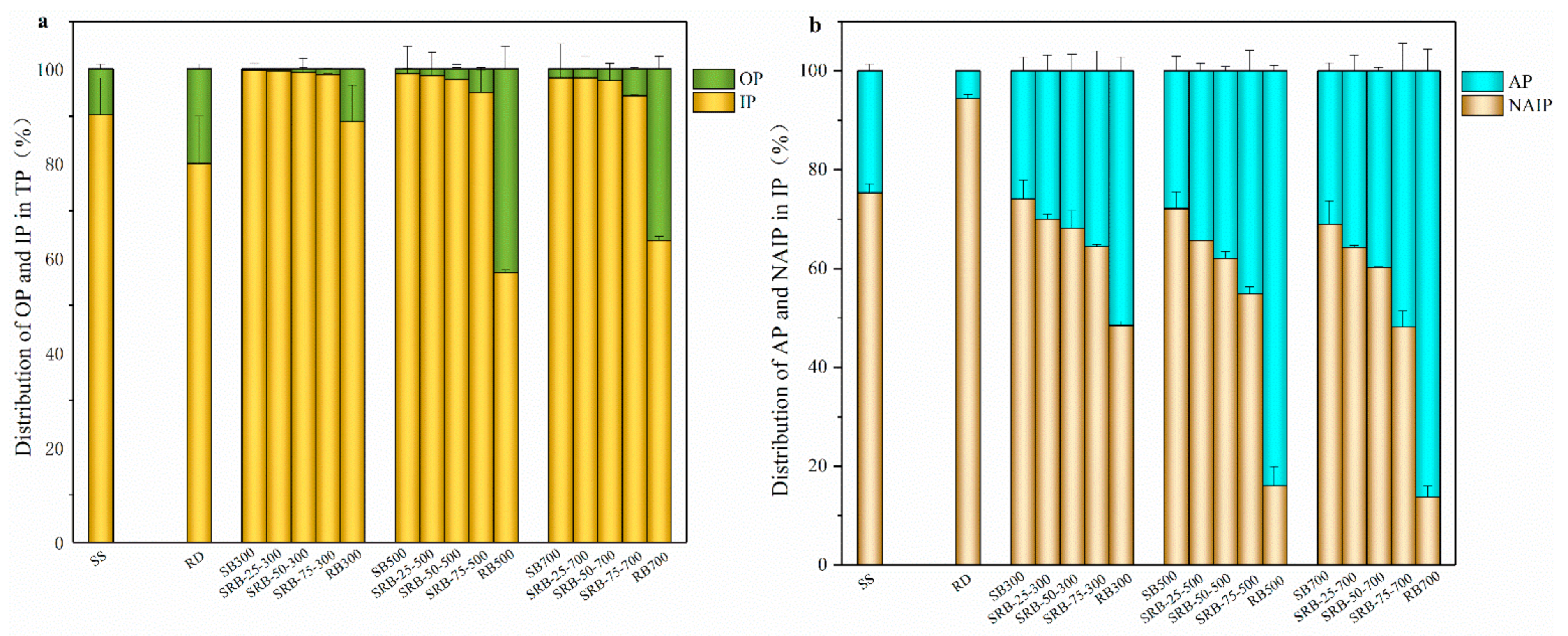

| Sample | TP | IP | OP | NAIP | AP | TP Recovery (%) |
|---|---|---|---|---|---|---|
| (mg g−1) | ||||||
| SS | 21.0 ± 0.2 | 15.8 ± 1.4 | 1.69 ± 0.17 | 8.53 ± 0.20 | 2.79 ± 0.16 | |
| RD | 0.39 ± 0.04 | 0.16 ± 0.02 | 0.04 ± 0.00 | 0.17 ± 0.00 | 0.01 ± 0.00 | |
| SB300 | 29.8 ± 0.6 | 25.7 ± 0.4 | 0.07 ± 0.05 | 13.5 ± 0.7 | 4.72 ± 0.52 | 99.2 |
| SB500 | 30.9 ± 0.1 | 26.1 ± 1.5 | 0.27 ± 0.04 | 14.7 ± 0.7 | 5.69 ± 0.59 | 96.0 |
| SB700 | 33.0 ± 1.2 | 27.7 ± 2.1 | 0.55 ± 0.05 | 15.2 ± 1.1 | 6.85 ± 0.35 | 96.0 |
| SRB-25-300 | 24.5 ± 0.8 | 21.1 ± 0.1 | 0.09 ± 0.00 | 10.4 ± 0.2 | 4.47 ± 0.47 | 96.6 |
| SRB-25-500 | 26.9 ± 1.1 | 23.7 ± 1.2 | 0.35 ± 0.00 | 11.1 ± 0.0 | 5.82 ± 0.25 | 96.4 |
| SRB-25-700 | 27.5 ± 1.7 | 25.9 ± 1.2 | 0.51 ± 0.03 | 12.2 ± 0.1 | 6.79 ± 0.61 | 92.4 |
| SRB-50-300 | 17.9 ± 0.2 | 15.3 ± 0.5 | 0.11 ± 0.04 | 7.89 ± 0.41 | 3.69 ± 0.39 | 92.3 |
| SRB-50-500 | 19.9 ± 1.3 | 19.4 ± 0.6 | 0.45 ± 0.06 | 8.14 ± 0.19 | 4.98 ± 0.11 | 90.4 |
| SRB-50-700 | 21.1 ± 1.7 | 19.7 ± 0.7 | 0.49 ± 0.00 | 9.18 ± 0.02 | 6.08 ± 0.11 | 89.1 |
| SRB-75-300 | 10.1 ± 1.0 | 9.69 ± 0.02 | 0.12 ± 0.01 | 4.47 ± 0.03 | 2.46 ± 0.28 | 88.8 |
| SRB-75-500 | 11.0 ± 0.2 | 10.1 ± 0.5 | 0.53 ± 0.03 | 4.53 ± 0.12 | 3.72 ± 0.34 | 81.8 |
| SRB-75-700 | 12.4 ± 0.2 | 11.7 ± 0.0 | 0.71 ± 0.03 | 4.66 ± 0.32 | 5.01 ± 0.55 | 83.3 |
| RB300 | 0.91 ± 0.07 | 0.80 ± 0.07 | 0.10 ± 0.00 | 0.32 ± 0.01 | 0.34 ± 0.02 | 87.3 |
| RB500 | 1.21 ± 0.04 | 0.61 ± 0.01 | 0.46 ± 0.05 | 0.09 ± 0.02 | 0.47 ± 0.01 | 98.2 |
| RB700 | 1.32 ± 0.03 | 0.79 ± 0.01 | 0.45 ± 0.03 | 0.08 ± 0.01 | 0.50 ± 0.03 | 96.8 |
| Sample | Cr | Ni | Cu | Zn | Pb |
|---|---|---|---|---|---|
| (mg kg−1) | |||||
| SS | 182 ± 2 | 64.3 ± 1.4 | 122 ± 1 | 829 ± 12 | 53.4 ± 2.0 |
| RD | 93.9 ± 8.6 | 7.78 ± 2.7 | 9.07 ± 3.19 | 37.7 ± 5.0 | 1.04 ± 0.12 |
| SB300 | 261 ± 1 | 88.9 ± 1.2 | 169 ± 1 | 1218 ± 18 | 71.7 ± 0.1 |
| SB500 | 272 ± 2 | 95.6 ± 1.6 | 182 ± 5 | 1289 ± 9 | 77.2 ± 1.1 |
| SB700 | 290 ± 6 | 100 ± 2 | 192 ± 3 | 1372 ± 29 | 81.5 ± 0.9 |
| SRB-25-300 | 284 ± 4 | 85.1 ± 0.0 | 148 ± 9 | 987 ± 5 | 60.1 ± 0.6 |
| SRB-25-500 | 360 ± 10 | 104 ± 3 | 165 ± 3 | 1110 ± 6 | 66.1 ± 0.4 |
| SRB-25-700 | 371 ± 3 | 104 ± 2 | 175 ± 0 | 1188 ± 5 | 68.4 ± 0.4 |
| SRB-50-300 | 263 ± 7 | 72.2 ± 1.9 | 113 ± 2 | 791 ± 2 | 46.4 ± 0.2 |
| SRB-50-500 | 307 ± 5 | 78.3 ± 1.7 | 125 ± 3 | 879 ± 20 | 52.1 ± 1.0 |
| SRB-50-700 | 377 ± 8 | 87.6 ± 0.7 | 141 ± 2 | 984 ± 6 | 53.9 ± 0.6 |
| SRB-75-300 | 215 ± 6 | 44.0 ± 4.6 | 75.1 ± 2.8 | 511 ± 3 | 26.8 ± 0.2 |
| SRB-75-500 | 277 ± 3 | 45.6 ± 2.4 | 85.7 ± 2.5 | 589 ± 25 | 31.4 ± 1.4 |
| SRB-75-700 | 324 ± 3 | 53.5 ± 4.1 | 93.3 ± 5.9 | 645 ± 3 | 27.4 ± 0.0 |
| RB300 | 222 ± 4. | 15.1 ± 7.1 | 17.9 ± 1.4 | 77.1 ± 1.2 | 2.51 ± 0.09 |
| RB500 | 306 ± 7 | 33.8 ± 2.1 | 31.0 ± 3.7 | 103 ± 3 | 3.65 ± 0.52 |
| RB700 | 378 ± 4 | 26.3 ± 1.6 | 33.0 ± 2.9 | 105 ± 2 | 2.66 ± 0.08 |
| Threshold values a | |||||
| Grade A | 500 | 100 | 500 | 1200 | 300 |
| Grade B | 1000 | 200 | 1500 | 3000 | 1000 |
Publisher’s Note: MDPI stays neutral with regard to jurisdictional claims in published maps and institutional affiliations. |
© 2022 by the authors. Licensee MDPI, Basel, Switzerland. This article is an open access article distributed under the terms and conditions of the Creative Commons Attribution (CC BY) license (https://creativecommons.org/licenses/by/4.0/).
Share and Cite
Gbouri, I.; Yu, F.; Wang, X.; Wang, J.; Cui, X.; Hu, Y.; Yan, B.; Chen, G. Co-Pyrolysis of Sewage Sludge and Wetland Biomass Waste for Biochar Production: Behaviors of Phosphorus and Heavy Metals. Int. J. Environ. Res. Public Health 2022, 19, 2818. https://doi.org/10.3390/ijerph19052818
Gbouri I, Yu F, Wang X, Wang J, Cui X, Hu Y, Yan B, Chen G. Co-Pyrolysis of Sewage Sludge and Wetland Biomass Waste for Biochar Production: Behaviors of Phosphorus and Heavy Metals. International Journal of Environmental Research and Public Health. 2022; 19(5):2818. https://doi.org/10.3390/ijerph19052818
Chicago/Turabian StyleGbouri, Ilham, Fan Yu, Xutong Wang, Junxia Wang, Xiaoqiang Cui, Yanjun Hu, Beibei Yan, and Guanyi Chen. 2022. "Co-Pyrolysis of Sewage Sludge and Wetland Biomass Waste for Biochar Production: Behaviors of Phosphorus and Heavy Metals" International Journal of Environmental Research and Public Health 19, no. 5: 2818. https://doi.org/10.3390/ijerph19052818





